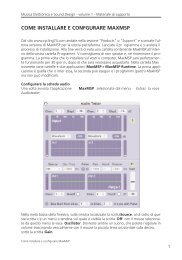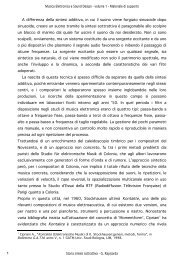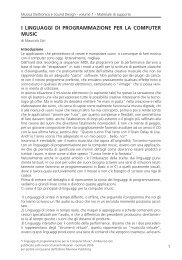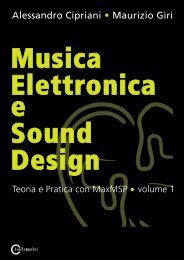programming with max/msp - Virtual Sound
programming with max/msp - Virtual Sound
programming with max/msp - Virtual Sound
You also want an ePaper? Increase the reach of your titles
YUMPU automatically turns print PDFs into web optimized ePapers that Google loves.
Chapter 3P - Noise generators, filters, and subtractive synthesis<br />
3.1 SOUND SOURCES FOR SUBTRACTIVE SYNTHESIS<br />
As you learned in Section 3.1T, the purpose of a filter is to modify the spectrum<br />
of a signal in some manner. In this section, before introducing filtering in<br />
Max/MSP, we will introduce an object that you can use to display a spectrum:<br />
the spectroscope~ object. This graphical object can be found near the end<br />
of the palette, in the vicinity of the scope~ object (as shown in Figure 3.1). As<br />
usual, if you can’t find it in the palette, create an object box and type the name<br />
“spectroscope~” into it.<br />
Fig. 3.1 The spectroscope~ object<br />
Open the file 03_01_spectroscope.<strong>max</strong>pat (shown in Figure 3.2).<br />
Fig. 3.2 The file 03_01_spectroscope.<strong>max</strong>pat<br />
In this patch, we have connected a selector~ object to the spectroscope<br />
so that we can switch between three oscillators, one generating a sine wave<br />
(cycle~), one generating a non-band-limited sawtooth wave (phasor~), and<br />
one generating a band-limited sawtooth wave 1 (saw~). The three message<br />
boxes connected to the left input of the selector~ object are used to pick<br />
one of the three oscillators; by setting the frequency in the float number box<br />
and then moving between the three oscillators, you can compare their spectra.<br />
Observe that the sine wave has only one component, while the phasor~,<br />
being a non-band-limited object, has a much richer spectrum. 2<br />
1 See Section 1.2.<br />
2 The spectroscope~ object uses an algorithm for spectral analysis called the Fast Fourier<br />
Transform. We already mentioned the Fourier theorem at the end of Chapter 2T, and we will return<br />
to a much more detailed discussion of it in Chapter 12.<br />
from “Electronic Music and <strong>Sound</strong> Design” Vol. 1 by Alessandro Cipriani and Maurizio Giri<br />
© ConTempoNet 2010 - All rights reserved<br />
3P<br />
357







